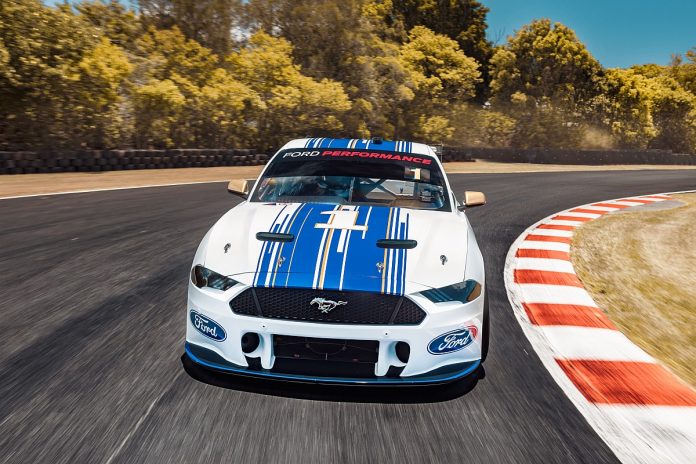The next-generation cars, slated to launch next season, will be built on a new control suspension that’s better suited to two-door body styles like the Ford Mustang and the Chevrolet Camaro.
The lower rolling tire avoids the strange dimensions of the current Mustang, which was built over a chassis originally intended for the four-door sedans like the Ford Falcon and Holden Commodore.
That, combined with a massive drop in downforce, will likely result in the Gen3 cars offering a much more faithful rendering of their street counterparts.
Burgess says the Dick Johnson Racing (Ford) and Triple Eight (GM) homologation teams had an extra month tweaking early designs to ensure they contained as much street car DNA as possible.
Now that he’s seen near-final designs, the cars look sensational, although the renderings released last year won’t necessarily be a very accurate guide to what the final product will be.
“I don’t want to compare them to the renders, the renders were done very early in the play,” he said.
“But what I can say is that we purposely built for a month … I wouldn’t say there was lag, but we allowed both manufacturers to incorporate as much street car DNA into the styling of the cars.
“They look sensational to me. We’re not quite ready to show them yet; the two manufacturers have to give us permission to do so.
“But there will be a lot more street car DNA in them than we’ve ever seen in a supercar. I don’t think anyone will be disappointed when they see them.
“It no longer has a large rear wing because we are no longer trying to generate around 400, 450 kilos of downforce, we will be at 150 kilos, or roughly in that range.
“The number is not the be-all and end-all. It’s about achieving parity between the two and maintaining the correct aerodynamic drag in the cars.
“Of course we don’t want to go over 300 km / h in Bathurst. So we did a lot of simulations with a projected final weight for the car where we think we will end at the weight.” where we want to be in terms of engine performance and where we want to be in terms of downforce and drag.
“But the outer skin of the cars is now both pretty well closed, we’re finishing the cooling work and making sure that both cars have the right amount of cooling for these engines.
“Obviously with these engines, engines of modern architecture with alloy blocks as opposed to a cast iron block, the cooling requirement is much greater than with an iron block. So we just make sure we have the correct cooler ducts and core sizes.
“But the position of the radiator and the position of the wheel boxes, that’s all set. We just make sure we have parity at least on CFD before we go on the runway and do a VCAT.”
This CFD work will be carried out by Supercars’ aero partner, UK company D2H, before VCAT – real straight line tests on an airport runway – will determine the final aero homologation later in the development process.
“We go through the options we have in the splitter position, in the rear wing position in X and Y, in the width of the rear wing element… we just run tests to make sure we have enough tunability to be able to parry [the two models]“Added Burgess.
“We’re going to get parity for sure in CFD. But once we get them out on the runway to account for small differences, we make sure we have enough range to tailor both cars to the desired outcome.
“And all of the work we’ve done on the last couple of VCATs, you know … nobody mentions the P-word anymore, which is very satisfying.
“We believe we won’t have a problem getting both cars balanced and with the right drag and downforce we’re looking for.”
The Mustang caused significant aerodynamic headaches in supercars when it was first introduced in 2019 along with the four-door ZB Commodore.
The car’s aerodynamic performance quickly came under fire, with supercars going through a series of CFD-assisted aero tweaks on both cars during the season before having two cracks at VCAT ahead of the 2020 season.
Supercars hopes to start track testing with its Gen3 prototypes in August.

